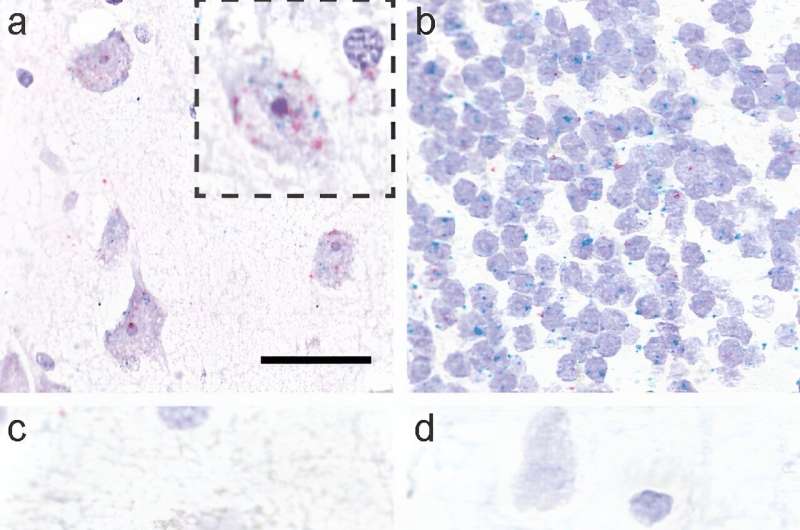This article has been reviewed according to Science X's editorial process and policies. Editors have highlighted the following attributes while ensuring the content's credibility:
fact-checked
trusted source
proofread
Study suggests two-pronged approach to treatment for neurodegenerative disease

Researchers at the University of Toronto's Tanz Center for Research in Neurodegenerative Diseases have used novel techniques to uncover which subtypes of brain cells express genetic material that produces tau, a key protein involved in the development of the neurodegenerative disease progressive supranuclear palsy (PSP).
The study, published recently in the journal Acta Neuropathologica, suggests that a two-pronged approach to treatment that targets two key mechanisms in disease development may be more effective than current methods.
"This study uses a novel methodology to show that the glial cells—the supporting brain tissue—can produce tau themselves and become diseased without taking up tau from nerve cells. Therefore, glial cells are more important in disease pathogenesis than previously assumed," says Gabor Kovacs, investigator at the Tanz Center and a professor in the Temerty Faculty of Medicine's department of laboratory medicine and pathobiology.
"This study also shows that RNA expression of tau, thus the production of tau, is preserved during disease and providing a continuous supply of tau, which should be kept in mind in therapy development."
One of the most common features of neurodegenerative diseases such as PSP and Alzheimer's disease is the accumulation of misfolded tau protein in neurons and their supporting cells, impairing the function of these cells.
Researchers have long debated which brain cells express the gene MAPT, which codes for tau. For decades, the dominant view has been that neurons express MAPT RNA, but glial cells do not.
Shelley Forrest, a neuropathologist and research associate with Kovacs' team, says that neuropathologists have observed that glial cells contain tau aggregates, but there was no solid evidence about where it was coming from.
"In these neurodegenerative diseases, we find pathological tau aggregates in the glia, so there's always been active debate on why tau pathology accumulates in glia, and whether it's produced by neurons and taken up by glia or whether glia can make it themselves independently," says Forrest.
The research team, which included collaborators in Australia and Dubai, examined brain tissue samples from three patients who had PSP and three who did not. Having access to these post-mortem patient samples—which Forrest describes as "the most generous gift anyone can give"—allowed the researchers to have a more complete and realistic view of the RNA expression in different brain cell types compared to using animal models or cell cultures.
The team used innovative RNAscope technology to visualize RNA molecules under the microscope, as well as single nucleus RNA sequencing, in order to map RNA expression in different brain regions and different types of brain cells. The patient samples combined with the new technology allowed the researchers to visualize for the first time where MAPT RNA is expressed in the brain.
The team found that different brain regions and brain cells differ in the amount of MAPT RNA they express. And, importantly, they identified that glial cells do express MAPT RNA—providing the first solid evidence of its presence in these cells. This means that glial cells are not only taking up misfolded tau produced by neurons, but are also making it themselves.
"We've long had this suspicion, but now we've been able to get the evidence to demonstrate that this is the case," says Forrest. "How and why tau accumulates in glia in PSP is not entirely clear, but our study highlights two novel mechanistic pathways for the cell-to-cell transmission of misfolded tau and accumulation in the brain, which is an exciting result."
The study results suggest that a two-pronged approach to therapy—targeting both the misfolded tau protein and MAPT RNA expression—could be the best strategy for treating PSP and similar diseases.
"Because we're proposing two different pathways for the pathogenesis of the disease, if you only focus on one, you're just getting half the picture," says Forrest. "If you block one pathway, it will just proceed with the other pathway. You've got to block both."
Kovacs' team will now use similar techniques to study this same question in other neurodegenerative diseases. They will also follow up on their results to understand RNA expression across the different brain regions.
"Our team is one of the first to use these techniques in neurodegenerative-diseased human brain samples. We will now expand this examination to other diseased proteins and map how changes in the tau RNA expression affect expression of crucial genes at the cellular level, focusing on glial cells," Kovacs says.
"Ultimately, this work will inform basic researchers to focus on glial cells—not just neurons—when trying to unravel the pathogenesis of PSP, and will inform therapy developers to not only remove misfolded tau as they currently do, but also decrease production of normal tau using RNA-based therapies."
More information: Shelley L. Forrest et al, Cell-specific MAPT gene expression is preserved in neuronal and glial tau cytopathologies in progressive supranuclear palsy, Acta Neuropathologica (2023). DOI: 10.1007/s00401-023-02604-x





















